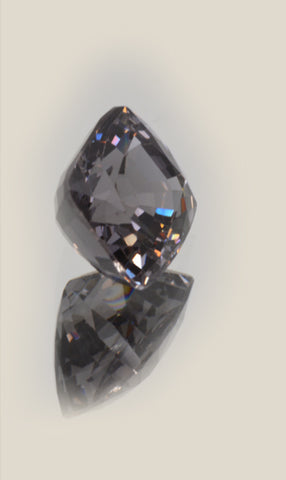Your cart (0)
Your cart is empty
Tax included and shipping calculated at checkout
Drawer menu
Tax included and shipping calculated at checkout
SPINEL GEMSTONE BUYING GUIDE
Color and Price, Cut and Sizes, Clarity and Typical Inclusions, Where is Found, August Birthstone, Famous Spinel, General Description
Talk about SPINELS is to talk of history, the birth of Gemology, of wars and crowns, but above all, of a great gemstone which is rising from the ashes, like the Phoenix, but on this occasion, it was a long times: TWO CENTURIES.
Contents
Spinel Gemstone and Ruby have many things in COMMON, and therefore have been confused for centuries.
The Spinel Gemstone is an oxide of aluminum and magnesium; and Ruby is an aluminum oxide; once the magnesium is depleted, the spinel stops their growth, to start to crystallize the ruby. This is one of the main reasons why are found in the same deposits. It must also be added that Red - Pink Spinels and Rubies have the same chromophore element (Cr 3+). It is easy to understand why both gemstones, spinel and ruby, have been mistaken for centuries.
In 1783, Jean Baptiste Louis Rome de Lisle, mineralogist, identifies the spinel like a different mineral from ruby. So born a new discipline: GEMOLOGY. It was at this moment when it began the decline of spinel, and it was ostracided
The origin of the name is uncertain. In the Middle Ages, Albertus Magnus wrote a mineralogical book in which differentiated the "carbuncles" in three; the Romans associated the red gemstones to the red-hot coals (carbuncles):
1. Carbuncle rubinus (ruby). The more intense red color.
2. Carbuncle balagius (spinel). Our Balas Ruby (Spinels from Badakhshan) o red spinels.
3. Carbuncle granatus (garnet). The more darker red color.
It is likely that because often is twinned with herringbone form, or in allusion to its pointed crystals (octahedrons), spinel’s name arises from the Latin word "spina" or of the french word "spinelle". The term "Balas Ruby" has been used in the past to refer to spinels from Badakhashan's mines.
Spinel Gemstone is often cut into cushion shapes because of its octahedron crystalline habit. Oval, rounds and emerald shapes are very frequent. Some spinels are a perfect octahedra, in Burma is said to these spinels have been polished by the spirits, these pieces are mounted without cutting.
Spinel is cuted trying to maximize the weight retention of the rough.
Spinel is available in large sizes, but finest Red, Pink and Blue Spinels over 5 ct are rare and much appreciated.
Red and Pink Spinels will show eye-visible inclusions, while generally are more cleaner than Ruby.
Typical inclusions: The main inclusions in Spinel Gemstones are healed fractures, solid inclusiones (apatite crystals are very common), boehmite tubes, fingerprinted (groups of Spinel octahedrons), octahedral negative crystals, fractures filled of iron oxides.
GENESIS: The spinel is mainly found as metamorphic mineral in gneissos and schists, and as a primary mineral in mafic igneous rocks. It is found in rocks rich in Al and Mg. It often appears associated with corundum.
Spinel Gemstones are found: Afghanistan, Burma (Myanmar), Cambodia, China, Madagascar, Pakistan, Russia, Sri Lanka (Blue - Violet), Tajikistan, Tanzania, Thailand (Black Spinels), United States, Vietnam...

ENHACENMENTS:
Spinel Gemstone is not usually enhanced, ocassionally oiling.
SYNTHESIS:
Synthetic spinels are available in the trade. Usually grown by the Verneuil technique, while we can find synthetic spinels grown by flux method (red and blue spinels, mainly).
In ancient times, spinels have been owned by kings, princes and emperors; spinels have served to pay battles, they have killed for them, and have been used as spoils of war. As a result of all these fabulous stories, spinel gemstones have finished adorning the most beautiful crowns that today can be found in the best museums in the world, albeit with another name: ruby.
BLACK PRINCE'S RUBY
The history of this spinel of 170 ct is one of the longest and is replete with military conflicts, wars, kings, victories and murders. He has survived the passing of time. Today this spinel of 170 ct is one of the main pieces of the British Imperial Crown.
THE TIMUR RUBY
A 350 ct stone presented to Queen Victoria by the East India Company in 1851, belongs to the British Royal Family ever since. The stone has several persian inscriptions that have made of it a legend.
THE SAMARIAN SPINEL
The world’s largest spinel, 500 cts. It’s said the stone adorned once the Golden Calf. With a hole in it, legend talks about a diamond covering the hole. It is part of the Iranian Crown Jewels.
IRANIAN CROWN JEWELS
No doutb, the most important collection of spinels.
The Empress’s Crown (two largest spinels - 80 cts aprox.), hat decoration (Spinel 50 cts), The Sword of Fath-Ali Shah Qajar (Spinels 40, 25 and 20 cts), The Naderi Throne, The Royal Mace, Sphere, Dagger, Flacon, Dish Cover, Globe, Kiani Crown, The Royal Sword, The Kiani Aigrette, Nader Shah’s Shield, etc.
Spinel and Peridot are the Birthstones for August. The Spinel is the latest stone to become part of the list of birthstones. In 2016, the American Gem Trade Association included the Spinel as the birthstone of August.
More information about Birthstones, stones for fortune, horoscope, birth signs, etc.
Solid inclusion (probably apatite) in Rich Purplish Red Burma Spinel Oval Cut 1.60 ct.
Solid inclusion (probably apatite) in Enchanting Pink Burmese Spinel. Oval Cut, 2.44 ct.
Group of Spinels (Octahedrons) in Pink Spinel. Oval Cut. 2.44 ct.